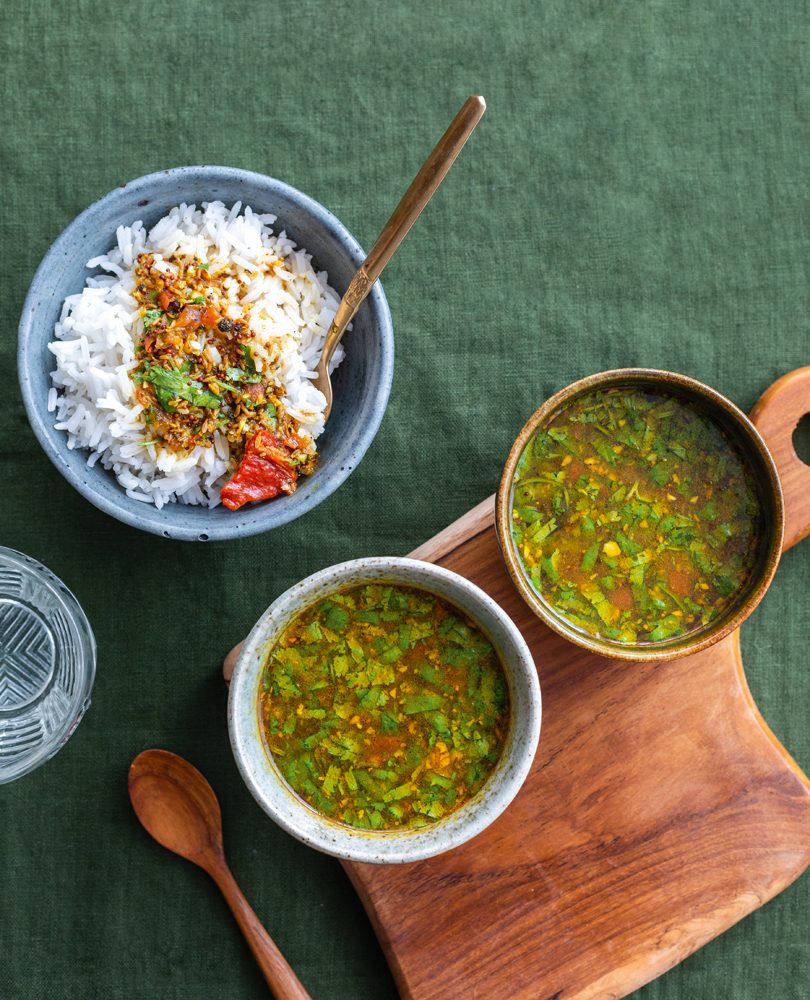RASAM
Emma Galloway

Serves
2Preparation
15 - 20 minsCook
10 minsIngredients
| 1 tablespoon seedless tamarind pulp | |
| 3 teaspoons cumin seeds | |
| 1-2 teaspoons black peppercorns | |
| 6 cloves garlic | |
| 1 tablespoon refined (odourless) coconut oil | |
| 1 teaspoon black mustard seeds | |
| 1 sprig curry leaves, stem discarded | |
| 1 dried red chilli, deseeded and roughly broken into pieces | |
| ¼ teaspoon ground turmeric | |
| 1 large ripe tomato, finely chopped | |
| pinch of asafoetida (optional) See NOTE | |
| small handful of coriander leaves and tender stems, roughly chopped | |
| cooked basmati rice, to serve (optional) |
There are as many different versions of rasam as letters in the alphabet and, like most recipes, I’m sure every south-Indian family has their own special version. Essentially it’s a heavily spiced broth which can be consumed as a soup (or healing tonic when sick) or eaten spooned over cooked basmati rice. Some recipes contain toor dal and use different spices but I’ve settled on a lovely warming rasam, heady with black pepper, slightly sweet from the addition of tomato and sour from tamarind. It’s the perfect thing to make up ahead of time, store in the fridge (where the flavours will develop even more) and then simply reheat when ready to serve. The heat level of this rasam is definitely not mild, more of a warming hum. If you don’t tolerate heat very well, omit the dried chilli and use 1 teaspoon (or less) of black peppercorns.
Instructions
| 1. | Put the tamarind into a bowl, pour over ½ cup boiling water and set aside for 10-15 minutes, stirring occasionally to break it up. |
| 2. | Strain through a fine sieve over a bowl and use the back of a spoon to press and scrape as much of the tamarind pulp through as you can, giving a runny tamarind liquid in the bowl. |
| 3. | Set aside and compost what’s left in the sieve. |
| 4. | Place the cumin seeds, black peppercorns and garlic into a mini food processor and blend until finely ground (alternatively you can use a mortar and pestle). |
| 5. | Heat the oil in a medium saucepan over a medium heat, add the mustard seeds, curry leaves and dried chilli and cook until the seeds start to pop. |
| 6. | Add the cumin mixture and continue to cook for 30 seconds, stirring continually. |
| 7. | Add the turmeric, tomato and asafoetida, if using, and continue to cook for 1-2 minutes, stirring often, until the tomato is soft. |
| 8. | Add 500ml (2 cups) cold water and the tamarind water, and bring to the boil. |
| 9. | Reduce to a simmer and cook for a couple of minutes. |
| 10. | Add the coriander and season well with fine salt. |
| 11. | Serve immediately as is, or spooned over cooked basmati rice. |
| 12. | NOTE Asafoetida, also known as hing, is a pungent powder made from the dried root gum of a plant similar to fennel. |
| 13. | The most common powdered form, available from Indian food stores, has wheat added to it (probably to prevent clumping), so if you are coeliac or gluten sensitive and can’t find the pure resin form, just omit it from the recipe. |
Recipes, food styling and photography Emma Galloway

Leave a Reply